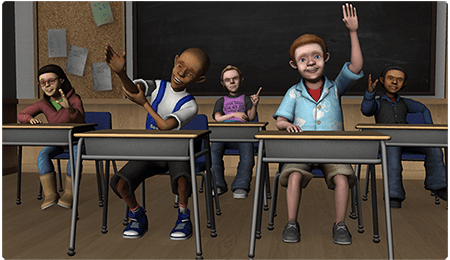Virtual Teaching May Help GTAs Prepare for the Classroom

An innovative tool with a new application in STEM education research may help prepare graduate teaching assistants (GTA) to transition from students to instructors.
Jackie Chini, an assistant professor in the UCF Physics Department, focuses her research on STEM education – or how to improve science teaching and learning. In her latest NSF-funded grant, she, along with co-researchers Erin Saitta of Chemistry and Charles Hughes of Computer Science and the Synthetic Reality Lab in the Institute for Simulation and Training, strives to prepare GTAs to teach science more effectively.
“There is a focus right now in STEM education to move away from strictly lecture-based learning. The first place a department makes that change is often in a lab or discussion section, usually taught by a graduate student,” Chini said. “If you survey the nation, most lab instruction is done by GTAs, many of whom were recently undergrads themselves and are now suddenly leading 20 to 50 students in a classroom.”
Saitta and Chini both research how to better teach complex subjects such as chemistry and physics. The $600,000 grant will expand on this research. TeachLivETM is a mixed-reality classroom simulator that will be used as a tool to prepare GTAs for the classroom. The simulator allows a GTA to practice teaching small groups of virtual students who take on different, realistic roles as learners. In the simulated classroom, the GTA will interact with five different students to practice a variety of skills.
“They re-teach the same lesson after they receive feedback,” Chini said. “Unlike real students, the virtual students can be ‘reset’, so the GTAs can practice the same lesson again and again.”
The technology was developed at UCF and has been used for a variety of research since its creation in 2007. The team is trying to figure out the best way to use the simulator to prepare GTAs for teaching undergraduate students.
“We are incorporating TeachLivETM into the professional development requirements for our GTAs,” Saitta said. “We already have the foundational evidence that it will work. From the research side, we will be able to measure how well it worked and in what context it works best.”
Chini says that, in past projects, international students who used TeachLivETM improved their confidence in the classroom. An unintended outcome, but a much added benefit. The simulator focuses on possible problem areas such as verbal communication between the student and GTA, body language and discourse.
“We ask GTAs to teach in a way they may not have experienced yet,” Saitta said. “They need assistance. These are difficult types of instructional strategies since they are not just talking to students, they are facilitating active learning.”
Chini says the team hopes to see improved learning and retention of the students and the GTAs who participate in the study. Simulators such as TeachLivETM have seen success in other industries, such as hospitality. A hotel chain uses similar software to train front-desk customer service staff.
“If we can prove that TeachLivETM works with this population, we can try and roll it out and share it with other institutions,” Chini said.
